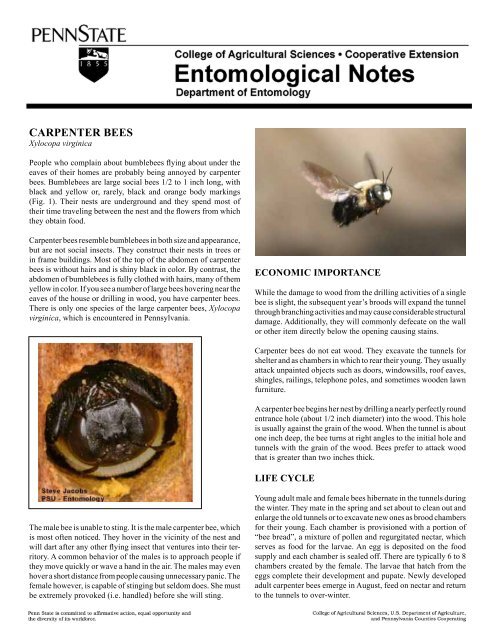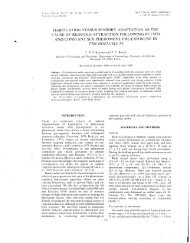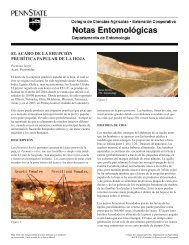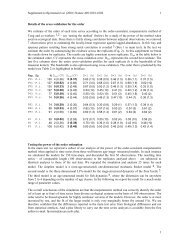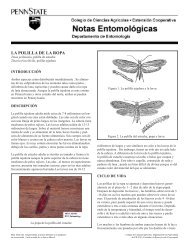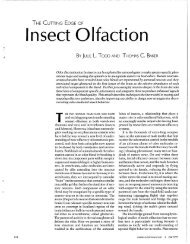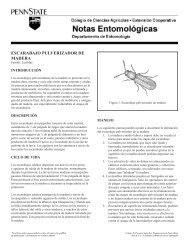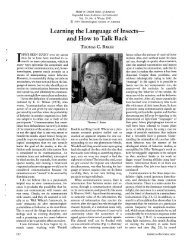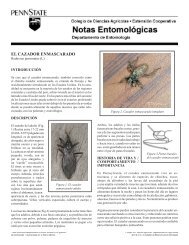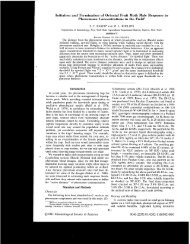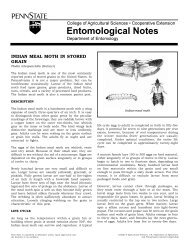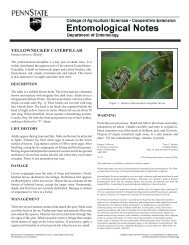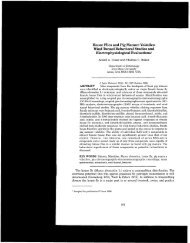PDF version of Carpenter Bees Fact Sheet - Entomology
PDF version of Carpenter Bees Fact Sheet - Entomology
PDF version of Carpenter Bees Fact Sheet - Entomology
Create successful ePaper yourself
Turn your PDF publications into a flip-book with our unique Google optimized e-Paper software.
CARPENTER BEESXylocopa virginicaPeople who complain about bumblebees flying about under theeaves <strong>of</strong> their homes are probably being annoyed by carpenterbees. Bumblebees are large social bees 1/2 to 1 inch long, withblack and yellow or, rarely, black and orange body markings(Fig. 1). Their nests are underground and they spend most <strong>of</strong>their time traveling between the nest and the flowers from whichthey obtain food.<strong>Carpenter</strong> bees resemble bumblebees in both size and appearance,but are not social insects. They construct their nests in trees orin frame buildings. Most <strong>of</strong> the top <strong>of</strong> the abdomen <strong>of</strong> carpenterbees is without hairs and is shiny black in color. By contrast, theabdomen <strong>of</strong> bumblebees is fully clothed with hairs, many <strong>of</strong> themyellow in color. If you see a number <strong>of</strong> large bees hovering near theeaves <strong>of</strong> the house or drilling in wood, you have carpenter bees.There is only one species <strong>of</strong> the large carpenter bees, Xylocopavirginica, which is encountered in Pennsylvania.Economic ImportanceWhile the damage to wood from the drilling activities <strong>of</strong> a singlebee is slight, the subsequent year’s broods will expand the tunnelthrough branching activities and may cause considerable structuraldamage. Additionally, they will commonly defecate on the wallor other item directly below the opening causing stains.<strong>Carpenter</strong> bees do not eat wood. They excavate the tunnels forshelter and as chambers in which to rear their young. They usuallyattack unpainted objects such as doors, windowsills, ro<strong>of</strong> eaves,shingles, railings, telephone poles, and sometimes wooden lawnfurniture.A carpenter bee begins her nest by drilling a nearly perfectly roundentrance hole (about 1/2 inch diameter) into the wood. This holeis usually against the grain <strong>of</strong> the wood. When the tunnel is aboutone inch deep, the bee turns at right angles to the initial hole andtunnels with the grain <strong>of</strong> the wood. <strong>Bees</strong> prefer to attack woodthat is greater than two inches thick.Life CycleThe male bee is unable to sting. It is the male carpenter bee, whichis most <strong>of</strong>ten noticed. They hover in the vicinity <strong>of</strong> the nest andwill dart after any other flying insect that ventures into their territory.A common behavior <strong>of</strong> the males is to approach people ifthey move quickly or wave a hand in the air. The males may evenhover a short distance from people causing unnecessary panic. Thefemale however, is capable <strong>of</strong> stinging but seldom does. She mustbe extremely provoked (i.e. handled) before she will sting.Young adult male and female bees hibernate in the tunnels duringthe winter. They mate in the spring and set about to clean out andenlarge the old tunnels or to excavate new ones as brood chambersfor their young. Each chamber is provisioned with a portion <strong>of</strong>“bee bread”, a mixture <strong>of</strong> pollen and regurgitated nectar, whichserves as food for the larvae. An egg is deposited on the foodsupply and each chamber is sealed <strong>of</strong>f. There are typically 6 to 8chambers created by the female. The larvae that hatch from theeggs complete their development and pupate. Newly developedadult carpenter bees emerge in August, feed on nectar and returnto the tunnels to over-winter.
managementLocate the wood in which the bees are active and apply an insecticidaldust directly into nest openings. This is best accomplishedby using a duster that will puff the dust up into the tunnel andcoat the sides. To avoid possible stings, treat the area at night.Use a flashlight, over which a piece <strong>of</strong> red cellophane has beentaped. The bees cannot see the red light, but you should be ableto see the openings. If you must treat during the daytime, use apyrethrum spray or wasp and hornet spray to knock down any beesflying about. It is advisable to wear protective clothing, gloves,goggles and a respirator or dust mask because the insecticidaldust will frequently become airborne and may drop down ontoyou as you dust the tunnel. Launder any contaminated clothingimmediately (do not mix with other household laundry items)and take a shower to remove and insecticidal dust. Because <strong>of</strong>the obvious risks associated with treating carpenter bee holes ineaves or s<strong>of</strong>fits, many homeowners will contract with a licensedpest control company to provide this service.Do not plug the holes immediately! The bees should be able topass freely through the nest entrance where they will contact thedust and distribute it inside the tunnels. Also any new maturedbees will emerge through the openings and contact the dust placedthere. It is a good idea to treat in the spring, when bees are firstobserved, again in mid-summer to kill any bees which may nothave acquired a sufficient treatment when they emerged, and athird time in early fall to contact any over-wintering bees occupyingthe tunnels. In the fall, the holes should be filled with woodputty or wooden dowels and the entire wood surface painted orvarnished. Stained wood is not usually protected from attack.WARNINGPesticides are poisonous. Read and follow directions and safetyprecautions on labels. Handle carefully and store in original labeledcontainers out <strong>of</strong> the reach <strong>of</strong> children, pets, and livestock.Dispose <strong>of</strong> empty containers right away, in a safe manner andplace. Do not contaminate forage, streams, or ponds.Steve JacobsSr. Extension AssociateDept. <strong>of</strong> <strong>Entomology</strong>Reviewed January 2014HP-2 © The Pennsylvania State University 2014This publication is available in alternative media on request.Where trade names are used, no discrimination is intended and no endorsement by The PennsylvaniaState University or Pennsylvania Department <strong>of</strong> Agriculture is implied.Entomological Notes are intended to serve as a quick reference guide and should not be usedas a substitute for product label information. Although every attempt is made to produceEntomological Notes that are complete, timely, and accurate, the pesticide user bears theresponsibility <strong>of</strong> consulting the pesticide label and adhering to those directions.Issued in furtherance <strong>of</strong> Cooperative Extension Works, Acts <strong>of</strong> Congress May 8 and June 30,1914, in cooperation with the U.S. Department <strong>of</strong> Agriculture and the Pennsylvania Legislature.D. Jackson, Director <strong>of</strong> Cooperative Extension, The Pennsylvania State University.The Pennsylvania State University is committed to the policy that all persons shall have equalaccess to programs, facilities, admission, and employment without regard to personal characteristicsnot related to ability, performance, or qualifications as determined by University policy orby state or federal authorities. It is the policy <strong>of</strong> the University to maintain an academic and workenvironment free <strong>of</strong> discrimination, including harassment. The Pennsylvania State Universityprohibits discrimination and harassment against any person because <strong>of</strong> age, ancestry, color,disability or handicap, national origin, race, religious creed, sex, sexual orientation, or veteranstatus. Discrimination or harassment against faculty, staff, or students will not be tolerated atThe Pennsylvania State University. Direct all inquiries regarding the nondiscrimination policyto the Affirmative Action Director, The Pennsylvania State University, 328 Bouke Building,University Park, PA 16802-5901, Tel 814-865-4700/V, 814-863-1150/TTY.


